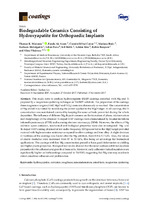Biodegradable ceramics consisting of hydroxyapatite for orthopaedic implants
Date
2017Author
Monsees, Thomas K.
Azem, Funda Ak
Cotrut, Cosmin Mihai
Braic, Mariana
Abdulgader, Radwan
Pana, Iulian
Birlik, Isil
Kiss, Adrian
Booysen, Robin
Vladescu, Alina
Metadata
Show full item recordAbstract
This study aims to analyze hydroxyapatite (HAP) coatings enriched with Mg and Ti
prepared by a magnetron sputtering technique on Ti6Al4V substrate. For preparation of the coatings,
three magnetron targets (HAP, MgO and TiO2) were simultaneously co-worked. The concentration
of Mg added was varied by modifying the power applied to the MgO target. In all coatings, the Ti
concentration was maintained constant by keeping the same cathode power fed during the whole
deposition. The influence of different Mg dopant contents on the formation of phase, microstructure
and morphology of the obtained Ti-doped HAP coatings were characterized by Fourier transform
infrared spectroscopy (FTIR) and scanning electron microscopy (SEM). Moreover, the effects of Mg
addition upon corrosion, mechanical and biological properties were also investigated. Mg- and
Ti-doped HAP coating obtained at low radio-frequency (RF) power fed to the MgO target provided
material with high corrosion resistance compared to other coatings and bare alloy. A slight decrease
in hardness of the coatings was found after the Mg addition, from 8.8 to 5.7 GPa. Also, the values
of elastic modulus were decreased from 87 to 53 GPa, this being an advantage for biomedical
applications. The coatings with low Mg concentration proved to have good deformation to yielding
and higher plastic properties. Biological test results showed that the novel surfaces exhibited excellent
properties for the adhesion and growth of bone cells. Moreover, early adherent vital cell numbers were
significantly higher on both coatings compared to Ti6Al4V, suggesting that Mg ions may accelerate
initial osteoblast adhesion and proliferation.

